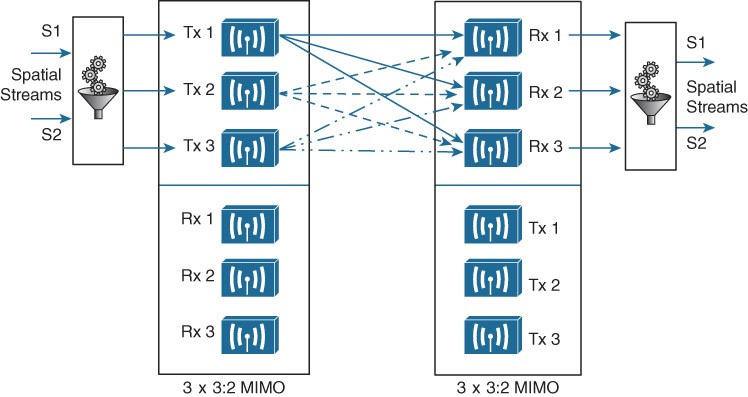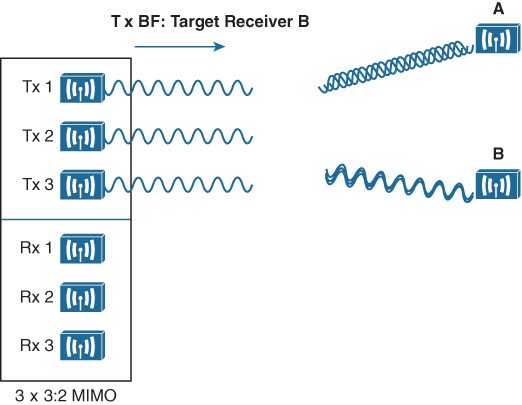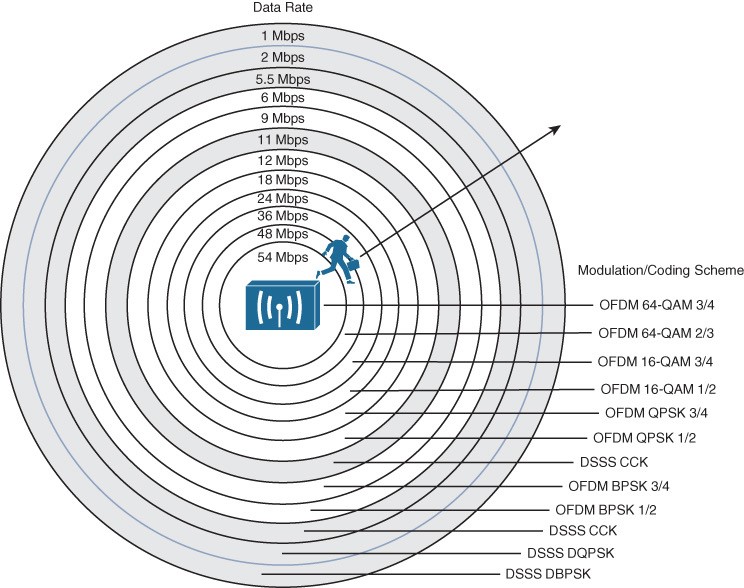
Carrying Data over a Wireless Signal
basic methods & standards involved in carrying data wirelessly between devices and the network.
 Modulation is the process by which a carrier signal changed in order to carry a data signal. Modulation is the process by which a carrier signal changed in order to carry a data signal. |
 Modulation schemes can alter frequency, phase or amplitude to indicate the zeroes and ones within the data transmission. Modulation schemes can alter frequency, phase or amplitude to indicate the zeroes and ones within the data transmission. |
 At the receiver, the process is reversed; demodulation interprets the added information based on changes in the carrier signal.(modem) At the receiver, the process is reversed; demodulation interprets the added information based on changes in the carrier signal.(modem) |
Modulation

- some scheme of altering some characteristic of the carrier signal to distinguish a 0 bit from a 1 bit.
- RF modulation schemes generally have the following goals:
- immune to interference and noise
- Be practical to transmit and receive
- Data being sent spread out across a range of frequencies, known as spread spectrum.
Direct sequence spread spectrum (DSSS): Used in the 2.4 GHz band, where a small number of fixed, wide channels support complex phase modulation schemes and somewhat scalable data rates, making it more resilient to disruption. 
 Orthogonal Frequency Division Multiplexing (OFDM): Used in both 2.4 & 5 GHz, where a single 20 MHz channel contains data sent in parallel over multiple frequencies. Each channel divided into many subcarriers (subchannels/tones); both phase and amplitude modulated with quadrature amplitude modulation (QAM) to move the most data efficiently.
Orthogonal Frequency Division Multiplexing (OFDM): Used in both 2.4 & 5 GHz, where a single 20 MHz channel contains data sent in parallel over multiple frequencies. Each channel divided into many subcarriers (subchannels/tones); both phase and amplitude modulated with quadrature amplitude modulation (QAM) to move the most data efficiently.
Maintaining AP – Client Compatibility
Each step in the 802.11 evolution involves an amendment to the standard, defining things like modulation and coding schemes, used to carry data.
| Standard | 2.4 GHz? | 5 GHz? | Data Rates Supported | Channel Widths Supported |
| 802.11b | Yes | No | 1, 2, 5.5, and 11 Mbps | 22 MHz |
| 802.11g | Yes | No | 6, 9, 12, 18, 24, 36, 48, and 54 Mbps | 22 MHz |
| 802.11a | No | Yes | 6, 9, 12, 18, 24, 36, 48, and 54 Mbps | 20 MHz |
| 802.11n | Yes | Yes | Up to 150 Mbps* per spatial stream, up to 4 spatial streams | 20 or 40 MHz |
| 802.11ac | No | Yes | Up to 866 Mbps per spatial stream, up to 4 spatial streams | 20, 40, 80, or 160 MHz |
| 802.11ax | Yes* | Yes* | Up to 1.2 Gbps per spatial stream, up to 8 spatial streams | 20, 40, 80, or 160 MHz |
*802.11ax is designed to work on any band from 1 to 7 GHz, provided that the band is approved for use.
Maintaining AP-Client Compatibility
Newer Wi-Fi Standards include:
- The 802.11n amendment (2009) in an effort to scale WLAN performance to a theoretical maximum of 600 Mbps. High throughput (HT) applied to either the 2.4 or 5 GHz band.
- The 802.11ac (2013) and brought even higher data rates through more advanced modulation and coding schemes, wider channel widths, greater data aggregation during a transmission. 802.11ac known as very high throughput (VHT), used only on the 5 GHz band.
- The 802.11ax amendment, Wi-Fi 6 and high efficiency wireless, aims to change the principle that only one device can claim airtime at a time by permitting multiple devices to transmit during the same window of air time.
- 802.11ax uses OFDM Access (OFDMA) to schedule and control access to the wireless medium, with channel air time allocated as resource units that can be used by multiple devices simultaneously.
Using Multiple Radios to Scale Performance
Before 802.11n, wireless devices used a single transmitter and a single receiver. The components formed one radio, resulting in a single radio chain, a single-in, single-out (SISO). One secret to the better performance of 802.11n, 802.11ac, 802.11ax is the use of multiple radio components, forming multiple radio chains. (MIMO system). 
Spatial Multiplexing

- Data multiplexed or distributed across two or more radio chains—all operating on the same channel, but separated through spatial diversity.
- Spatial multiplexing requires a good deal of digital signal processing on both the transmitting & receiving.
- The more spatial streams that are available, the more data sent over the channel. • When the sender and receiver have mismatched spatial stream support, they negotiate the connection and use the lowest number of streams in common.
Transmit Beamforming
- The 802.11n, 802.11ac, 802.11ax amendments offer a method to customize the transmitted signal to prefer one receiver over others.
- By leveraging MIMO, the same signal can be transmitted over multiple antennas to reach specific client locations more efficiently.
- With transmit beamforming (T×BF), the phase of the signal altered as it is fed into each transmitting antenna so that the resulting signals will all arrive in phase at a specific receiver.
 A device on the left using transmit beamforming to target device B on the right.
A device on the left using transmit beamforming to target device B on the right.
Dynamic Rate Shifting

The white circles denote OFDM (802.11g), the shaded circles contain DSSS (802.11b). Each move of the receiver away from the transmitter, into a larger concentric circle, causes a dynamic shift to a reduced data rate, in an effort to maintain the data integrity to the outer reaches of the transmitter’s range.
Other useful information: